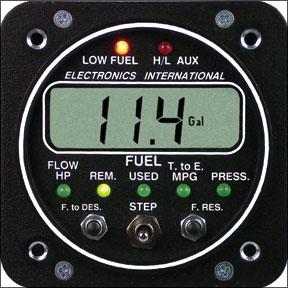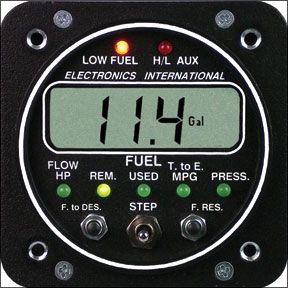One reason fuel mismanagement mishaps still comprise a large share of annual accident data is pilots forgetting to manage their fuel or doing it poorly. Another could be the less-than-exact instrumentation found aboard most GA aircraft. The bad news is only you can fix the pilot problem. 288 But there is good news: A fuel totalizer providing instantaneous fuel consumption data along with fuel remaining, endurance time and other useful information can eliminate shortcomings in the less-than-accurate fuel gauges installed in most personal aircraft. Even better news? When connected to a Loran or GPS, a totalizer and a navigator working together can supply distance-to-empty and reserve-at-destination information, along with your real-time mileage. How They Work Most fuel totalizers are stand-alone products; others require either a compatible GPS or an installed engine monitor to do their thing. Either way, youll find it harder to run out of fuel. Totalizers simply count the impulses generated by an engine-mounted transducer and convert the information into fuel consumption. Presuming the pilot tells it how much fuel is aboard, is configured properly and there are no leaks, any totalizer worthy of the name will display the real-time gallons, pounds, liters or other measurement unit per hour flowing into the engine. It will work with mogas, avgas or Jet A. It should display the endurance remaining until empty tanks, expressed in time, but its still up to the pilot to enter into the unit the correct fuel amount and switch tanks as appropriate to ensure the available fuel gets to the engine. A stand-alone unit installed in a non-pressurized single requires only a suitable cut-out in the instrument panel, passing three wires through the firewall and connecting them to the transducer, bolting the transducer to the top of the engine and installing a hose and appropriate fittings in the fuel line. A dedicated circuit breaker and appropriate wiring may also be necessary. Some aircraft-those with pressure carburetors, for example, and some fuel injection systems-return a variable amount of excess fuel to the tanks using a line past the point in the system where the transducer can be installed. Installing a second transducer in the return line, configured to subtract from the total, resolves this, presuming the totalizer can do the math. Then comes connecting the totalizer to the avionics. With that data, real-time mileage calculations, fuel remaining at destination or fuel required to the next fix information is available. Others send their fuel flow data to the navigator, allowing it to make its own calculations. Most totalizers are available in either a standard or optional configuration, allowing them to send and receive the necessary data. In its March 2008 issue, sister publication Aviation Consumer looked at a series of totalizers from various manufacturers. All of them come with a supplemental type certificate (STC) for at least one aircraft; many are STCd in hundreds of aircraft types through an approved model list. All comply with applicable technical standard orders (TSOs). Of the products Consumer looked at, only one-from Electronics International-offers a separate, higher-priced STC allowing its use as primary instrumentation. Whats Available Electronics International (EI) manufactures a full line of engine and systems instrumentation, including its FP-5 and FP-5L totalizers. Of the two, the FP-5L offers bidirectional communication with a Loran or GPS navigator. Unlike other manufacturers, EI makes its own transducer, saying it has benefits over the industry-standard product sold by Floscan and packaged by avionics makers. The FP-5 and 5L also offer multiple configurable alarms. Insight Instruments offers the True Flow 500. The product consists of a standard transducer with an added microprocessor, enabling communication with Loran and GPS navigators. Information presented by the True Flow 500 depends entirely on the navigator to which its connected. For example, you wont see real-time fuel flow unless your navigator is configured to display it. J.P. Instruments (JPI) offers two fuel totalizer solutions: the stand-alone FS-450 and an option for new and installed EDM-700 and -800 engine monitors. Like EIs product, the FS-450 is pretty much a do-it-all instrument, at least for singles. Out of the box, it incorporates send/receive capability with most Loran/GPS navigators. A twin-engine version is available, also. When the add-on option is used with JPI engine monitors, fuel flow information is recorded in the EDMs memory for later download. Sagem Avionics, a U.S. subsidiary of France-based SAFRAN, offers its FC-10 fuel computer, which formerly was an Arnav product and is standard equipment on Socatas TBM-700 turbine single. The company says “all” Lorans and GPS navigators are compatible with it. Perhaps the household name by which many fuel flow instruments are referred, Shadin Avionics offers three distinct totalizer products: the Digiflo-L, Miniflo-L (pictured above) and Microflo-L, the “-L” denoting ability to communicate bidirectionally with a Loran or GPS navigator. With certain exceptions, all three perform essentially the same functions. A major difference is in form factor and display. While most of the other totalizers on the market work and play well with Garmin, Bendix-King and maybe Apollo/UPSAT navigators, a Shadin totalizer can be configured to communicate with Northstar, Trimble, Arnav, Magellan, Skyforce and even B.F. Goodrich/Foster Loran and GPS boxes. Totalizer choices come down to how many engines need to be monitored, price, panel space and whether you want the unit to “talk” with your long-range nav system. Thirty years ago, we didnt have all these options. Thanks to the modern transducer and the microprocessors ability to count its transmitted impulses, we do. As one result, we should never again run out of fuel. Your mileage may vary, of course.




